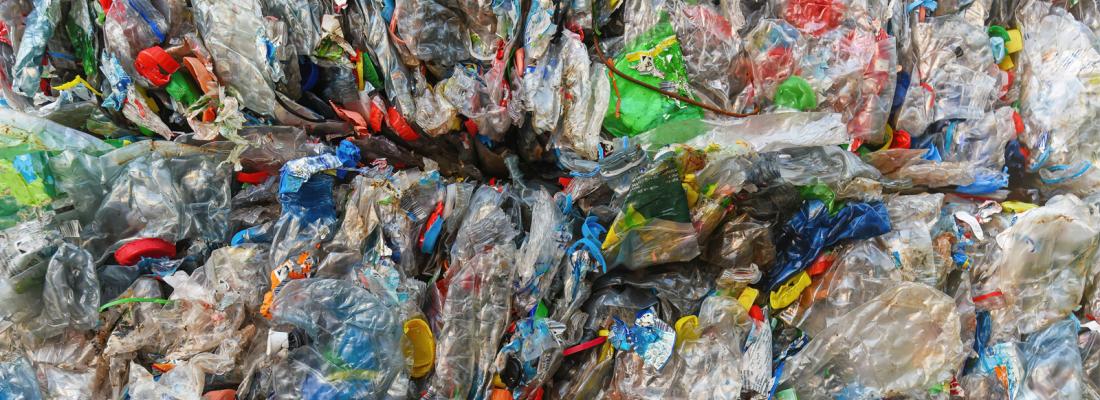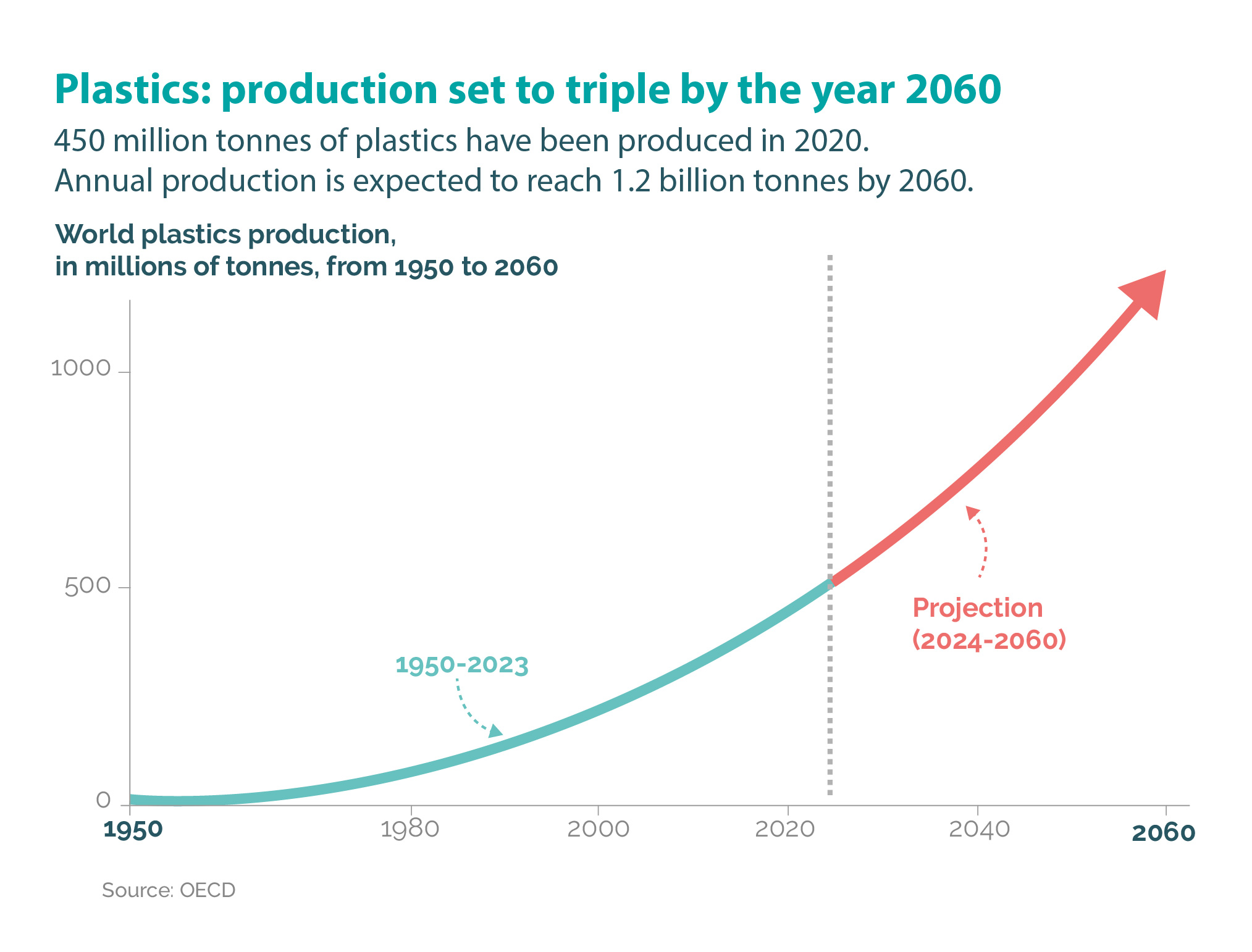Bioeconomy Reading time 6 min
The pernicious problem of plastic pollution: global challenges and solutions
Published on 18 April 2024

Plastic products are omnipresent in our daily lives. However, as they inevitably degrade, they release harmful, environmentally persistent particles that are a threat to human, animal, and ecosystem health. Inexpensive and highly malleable, plastic has many industrial and commercial uses. Created from petroleum, plastic is the third most manufactured material in the world, and its production levels have been growing steadily since the 1950s. If this trajectory is maintained, global plastic waste could triple by 2060 (source: OECD).
Plastic waste is problematic because it is not broken down during any of the Earth’s natural biogeochemical cycles, whose functioning is integral to ecosystem health. The carbon and water cycles, among others, ensure that elements flow among environmental reservoirs via a series of endlessly repeated phenomena. In contrast, plastic waste accumulates and breaks down extremely slowly, forming first microparticles and then nanoparticles. Both particle types perturb the environmental balance. These realities give rise to several important questions: What is the origin and extent of plastic pollution? How do we quantify levels of plastic pollution? Is recycling a viable solution?
Measuring the plastic footprint
A research director at the INRAE Centre of Occitanie-Montpellier, Nathalie Gontard is among a growing number of scientists who advocate adopting a new metric—the plastic footprint—to better characterise the specific risks of plastic pollution [1]. The French Economic, Social, and Environmental Council (CESE) included use of the plastic footprint in its list of recommendations submitted during negotiations around the global treaty to curb plastic pollution.
ndeed, more and more manufacturers are highlighting the low carbon footprints of their plastic products or are evaluating the latter’s effects via life cycle analysis (LCA), a standard technique for quantifying the environmental impacts of a given product, service, or process. However, neither carbon footprint estimates nor LCAs account for the environmental impacts of plastic fragmentation and plastic particle persistence, which are fundamental components of plastic pollution.
Plastic pollution is visible and invisible
We are all familiar with images of the plastic waste found in the world’s aquatic and terrestrial ecosystems. However, these visible signs reveal only one part of total plastic pollution.
- Around 34% of plastic packaging waste is incinerated and used to produce energy, a process that generates toxic emissions and CO2.
- 16% of such waste is buried, enveloped in large tarps, themselves made of plastic. As these materials degrade, they contaminate the soil.
Over time, plastics break down into invisible microplastics (size: > 5 mm) and nanoplastics (size: 1 nm to 1 μm). These tiny plastic fragments are capable of absorbing other pollutants and traversing various physical and biological barriers. They are highly persistent and almost impossible to eliminate...and they have spread across the globe. They can be found in our air, water, and soils; they are present even in the most remote parts of the world. For example, microplastics have been found at the summit of Mount Everest [2] as well as in the Arctic [3]. Living organisms such as animals and humans have not been spared. Indeed, microplastics have been detected in our bodies (e.g., in placental tissue[4], lung tissue [5], blood [6] , and stool [7]).
Plastic degrades during usage
Because of its inherent properties, plastic begins fragmenting as soon as it is used. For example, nearly 2/3 of the clothing made by the textile industry is manufactured from low-cost synthetic fibres (e.g., polyester), which are derived from petroleum. The resulting dresses, sweaters, and T-shirts start to release microfibres the first time they are washed. While it is difficult to accurately quantify levels of microfibre waste, one study has estimated that laundering synthetic textiles adds 500,000 tonnes of microfibres to the world’s oceans each year. Tire erosion is another major source of plastic pollution, releasing 6 million tonnes of plastic particles into the global environment each year (source: OPECST). Finally, the construction industry [8] (including the low-carbon construction sector) contributes to plastic pollution via the plastic materials it uses.
Recycling has its limits
Although frequently cited as a solution, recycling can only go so far in addressing the problem of plastic waste. Recycling involves recovering materials from waste products, which are reprocessed to create objects with equivalent properties as the objects of origin, all while limiting resource use.
"If we examine recycling dynamics in countries such as Germany and Austria, which claim to recycle close to 50% of their plastic waste, we see that their consumption of virgin plastic has not concomitantly declined by half. Indeed, it has yet to decrease at all. Thus, dependence on plastic has been maintained, and products made from natural materials remain at a competitive disadvantage." - Nathalie Gontard
Additionally, because plastic degrades, true recycling is rare. Gontard suggests that only bottles made from polyethylene terephthalate (PET) can actually be recycled, and they account for just 1–2% of plastic usage. Instead, plastic is most often "decycled", or reused to create objects of lesser quality than the original that are, ultimately, thrown away. Plastic packaging waste and empty bottles are employed to make sweaters, furniture, or flower pots, which continue to degrade, releasing micro- and nanoplastics. Consequently, plastic "decycling" creates products of altered quality and accelerates plastic fragmentation, a source of pollution that is not quantified in LCAs and carbon footprint estimates.
"When the argument is made that decycling is as efficient as recycling, it is because the metric of reference is the carbon footprint. The major concern is that recycling plastic objects accelerates their release of micro- and nanoplastics." - Nathalie Gontard
Reducing plastic production

Each year, French consumers utilise around 4.8 million tonnes of plastic, mostly in the form of packaging (46%). The OECD estimates that, in 2019, 460 million tonnes of plastic were produced worldwide, twice as much as in 2000. These figures make clear that the priority is to target production: the best way to limit waste is to never produce it in the first place. Such is the first axis of France’s 3R strategy—reduce, reuse, and recycle—which aims to eliminate single-use plastic packaging in the country by 2040. To limit unnecessary plastic packaging, Montpellier’s Research Unit for Agropolymer Engineering and Emerging Technologies (IATE) has spent several years developing a decision-making tool for manufacturers.
In addition, scientists and manufacturers are exploring alternative forms of packaging, such as those made from renewable non-food resources that can be reused, recycled, and biodegraded under natural conditions. These materials will sport a label indicating that they are OK for residential composting and will have been designed to degrade naturally as part of the carbon cycle. However, Gontard underscores that these alternatives must be employed in moderation. She has helped run various related European projects, EcoBioCAP, NoAW, and, most recently, AgriLoop, that have resulted in the development of a food tray made from agricultural and agrifood residues. She emphasises, "These solutions are only intended to be complementary in nature. The primary goal must be to reduce our excessive consumption [of packaging]. Then and only then should we adopt alternatives to replace the plastic products we cannot do without."
References
[1] Gontard N., David G., Guilbert A. et al. (2022). Recognizing the long-term impacts of plastic particles distortion in decision-making, Nature Sustainability, 5, 582-478, https://doi.org/10.1038/s41893-022-00863-2
[2] Napper I., Daviers, B., Clifford H., et al. (2020) Reaching new heights in plastic pollution – preliminary findings of microplastics on Mount Everest. One Earth, 3 (5), 621-630 https://doi.org/10.1016/j.oneear.2020.10.020
[3] Bergmann, M., Collard, F., Fabres, J. et al. (2022) Plastic pollution in the Arctic. Nature Reviews Earth & Environment 3, 323–337, https://doi.org/10.1038/s43017-022-00279-8
[4] Ragusa A., Svelato A., Santacroce C. et al. (2021) Plasticenta: First evidence of microplastics in human placenta. Environment International, 146, 321-630, https://doi.org/10.1016/j.envint.2020.106274
[5] Jenner L., Rotchell J., Bennett R. et al. (2022) Detection of microplastics in human lung tissue using µFTIR spectroscopy. Science of the Total Environment, 831, https://doi.org/10.1016/j.scitotenv.2022.154907
[6] Sun W., Jin C., Bai Y. et al. (2022). Blood uptake and urine excretion of nano and micro-plastics after a single exposure. Science of The Total Environment, 848, 157639, https://doi.org/10.1016/j.scitotenv.2022.157639
[7] Schwabl P. (2018). Des microplastiques retrouvés au niveau mondial dans les selles humaines. Une étude pilote. Hegel, 4 (4), 290-291, https://doi.org/10.3917/heg.084.0290
